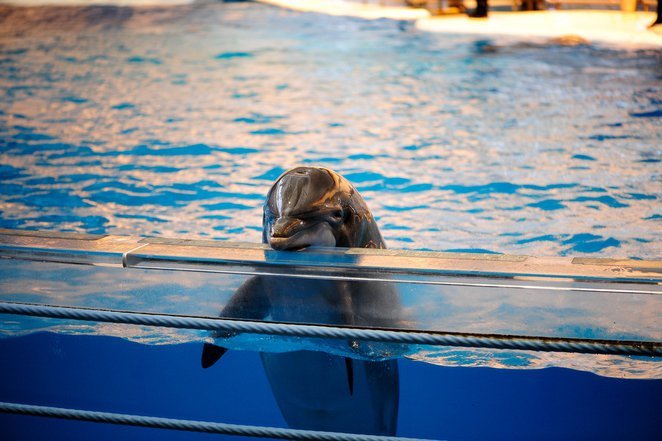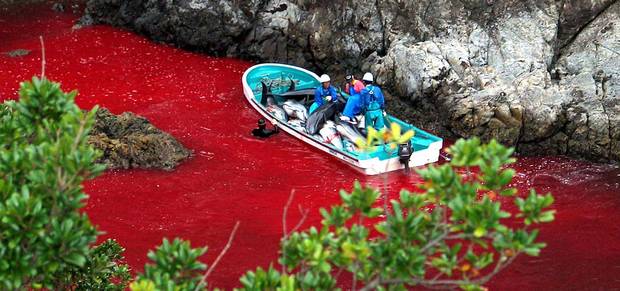
During the talk show, O'Barry said:
Host: When your dolphin, Flipper, as we call her, died in your arms, was that a turning point when you decided: "Okay, I don't want to be a trainer anymore, I want to be an activist"?In front of O'Barry sat Niels van Elk, marine biologist and vet of the Dolfinarium (marine mammal park in Harderwijk, the Netherlands). According to van Elk, when dolphins play in the Dolfinarium or in another zoo, it indicates that they are doing well, because if they didn't feel that way, they wouldn't play. O'Barry replied saying that these dolphins from captive breeding in the Dolfinarium have "never seen a live fish in their lives, they don't know what the current is, they don't know what the tide is, they think that the ceiling is the sky." He emphasized that "these are 'freaks' we've created for our amusement."
Ric O'Barry: It was a tipping point, but I had very strong feelings that led up to that. Because I was literally living with the dolphins for seven years. [...] You really get to know them, you get to know their body language. You can tell they're depressed. You're not fooled by that dolphin's smile anymore. That dolphin's smile is nature's greatest deception.
A good example is the Hagenbeck - zoo which is closed, by the way, because protesters were there every Sunday - where Sinbad one day jumped on the stage, like they do, and had a heart attack and died right on the stage. But the audience doesn't know that information. They see a dolphin laying on the stage just like that [points at a picture of a 'smiling' dolphin] with a big smile, and they're applauding a dead dolphin. It's just an example of how this industry is based on this optical illusion that dolphins smile.
Besides dolphins, orcas (also knows as killer whales) and beluga whales are also captured and contained to perform tricks. The first account of shipment of sea mammals to a museum in the US occurred in 1862, when six beluga whales were caught in the St. Lawrence River in New York and shipped to showman P.T. Barnum's museum. Five of them soon died, and the last one (after two years in captivity) was boiled alive when the museum caught fire and burned to the ground.
In the late 1870s, beluga whales and dolphins were being captured and shipped to aquaria and zoos throughout the US and Europe. The world's first marine mammal park, Marine Studios, which became Marineland of Florida in the 1970s, opened in 1938. Since then many more aquaria and mammal parks have opened. As O'Barry noted himself, especially when the TV series Flipper first aired in 1964, the capture of dolphins and whales became a multi-million-dollar business.
In the years that followed:
Between 1970 and 1971, ten orcas were captured from the Puget Sound off the coast of Washington state. Half of the animals were sent to SeaWorld, one (Lolita) was sent to Miami Seaquarium, and the other four were dispersed internationally. With the exception of Lolita, all of these orcas died prematurely in captivity. In the 15 years that followed this new wave of live-capture and export, up to 307 whales were captured, 13 died during the violent capture process, 55 were sent to aquariums. - Source

Since the documentary 'The Cove' exposed these practises, the fishermen have changed their killing method by pushing a sharp metal spike into the necks of the dolphins behind the blowholes, in order to damage the spinal cord in such a way as to cause instant death. Activists, however, have secretly filmed this new method, which doesn't appear to be any more humane because it still causes much suffering for the dolphins. Scientists agree:
In a 2013 study which appeared in the Journal of Applied Animal Welfare Science, scientists criticized the methods used by the fishermen, and said:Cetaceans are not only captured; some of them are born in captivity. Marine mammal parks such as SeaWorld collect the sperm of their captured orca and sell it for millions of dollars to other parks around the world to be used for captive breeding. At the Dolfinarium in the Netherlands, 36 dolphins kept there are the result of captive breeding. While a mother and her calf stick together for a long time in the wild, there have been times when offspring born in captivity were separated from their mothers. One tragic case concerns orca 'Kasatka' and her calf 'Takara' (from the documentary film 'Blackfish'):Our veterinary and behavioral analysis of video documentation of this method indicates that it does not immediately lead to death and that the time-to-death data provided in the description of the method, based on termination of breathing and movement, is not supported by the available video data.
A life in captivity can be depressing for these animals. During his work at the Miami Seaqarium, O'Barry said antidepressants (Prozac) were given to the dolphins to help them keep going. Another former trainer, John Hargrove, who worked at SeaWorld San Diego and SeaWorld San Antonio for a combined 14 years, said: "We had whales who were on medication every single day of their life." Other drugs used include antipsychotics and benzodiazepines.
At SeaWorld, orcas perform during the day and spend the night in a small enclosure with still water and all lights out. This is where they spend two-thirds of their lives. Taking into account that, in the wild, cetaceans travel for hundreds of miles, how does such a close enclosure impact their health and well-being? A paper by Jett and Ventre (2015) entitled "Captive killer whale (Orcinus orca) survival", states that: "Survival of captive killer whale cohorts has generally improved through time, although survival to age milestones are poor when compared to wild killer whales."
In another paper, by Doughtery (2013), "The Marine Mammal Protection Act: fostering unjust captivity practices since 1972", the author writes:
National Marine Fisheries Service (NMFS) is required to maintain life history records of these marine mammals in U.S. display facilities and all foreign dolphinaria and aquaria with which they trade. Entities under this requirement must submit their records to NMFS, to be retained and periodically updated in the Marine Mammal Inventory Report (MMIR). The inventories "chart a history of disturbing causes of death, high mortality rates, and low birth rates." [...]While much more can be said about the quality of life of cetaceans in a captive habitat, it is clear that there is serious concern about their life-span, and whether they would have lived longer and healthier lives in their natural surroundings.
Some marine parks have even been known to engage in outright lying. The Indianapolis Zoo's website reported the average life span of wild bottlenose dolphins as thirty-seven years until a newspaper noted that none of the zoo's captive dolphins lived past twenty-one years. Instead of using the opportunity to educate the public about the challenges of captive marine mammals, by which the zoo could have promoted its successes, their response was to change the website to say that wild dolphins live only seventeen years on average."'
One thing is certain: the way dolphins are captured, in particular those practices by Japanese fishermen in Taiji, is inhumane. It boggles the mind to think that this has not yet become illegal or been fully condemned by the authorities. It appears that living in a world where it's largely psychopaths in charge, power and money are of more importance than the lives of others, whether they be sea mammals or humans.




Great article. Considering the recent shooting of an endangered zoo gorilla, the past shooting and subsequent butchering of a young giraffe at another zoo, the shooting of a kingly lion by a cowardly dentist, we have to wonder what abyss human hearts have fallen into. Recently brought to my attention is that of no-kill shelters where cats, some feral and terrified, get to spend the remainder of their lives in cages, never feeling the earth under their feet or sun on their fur, hoarded up by their keepers.